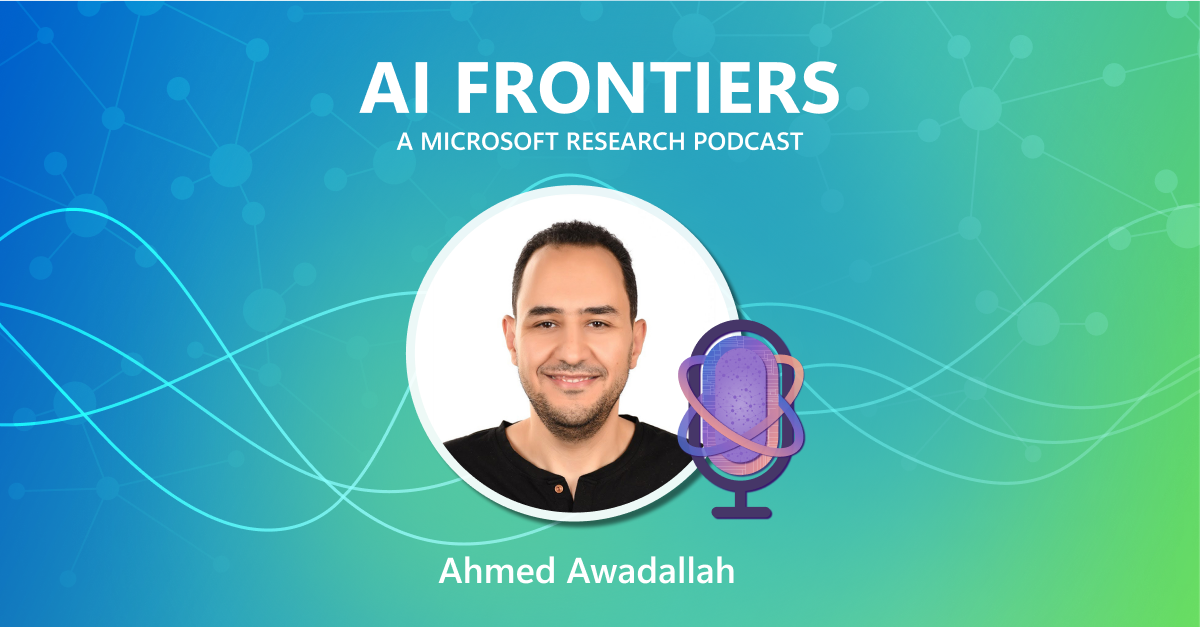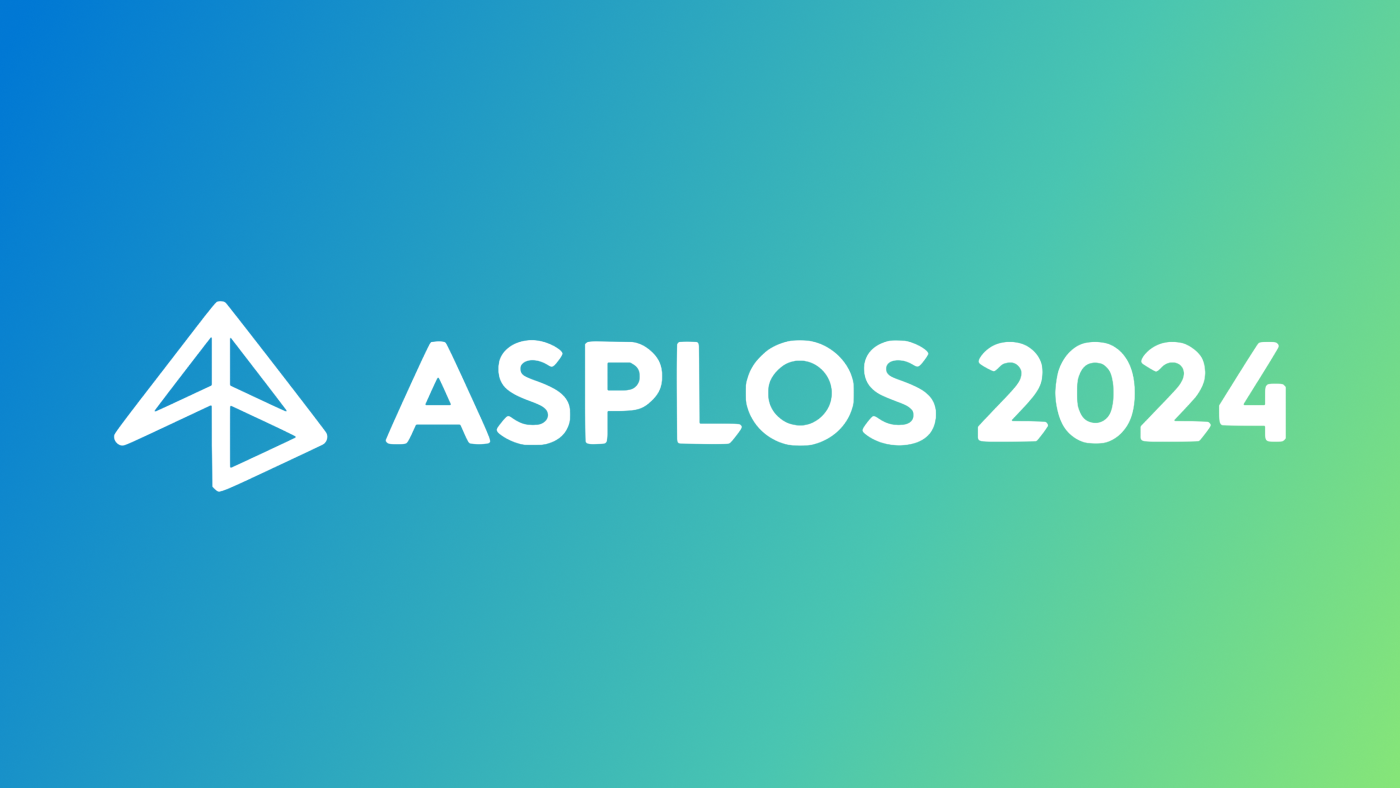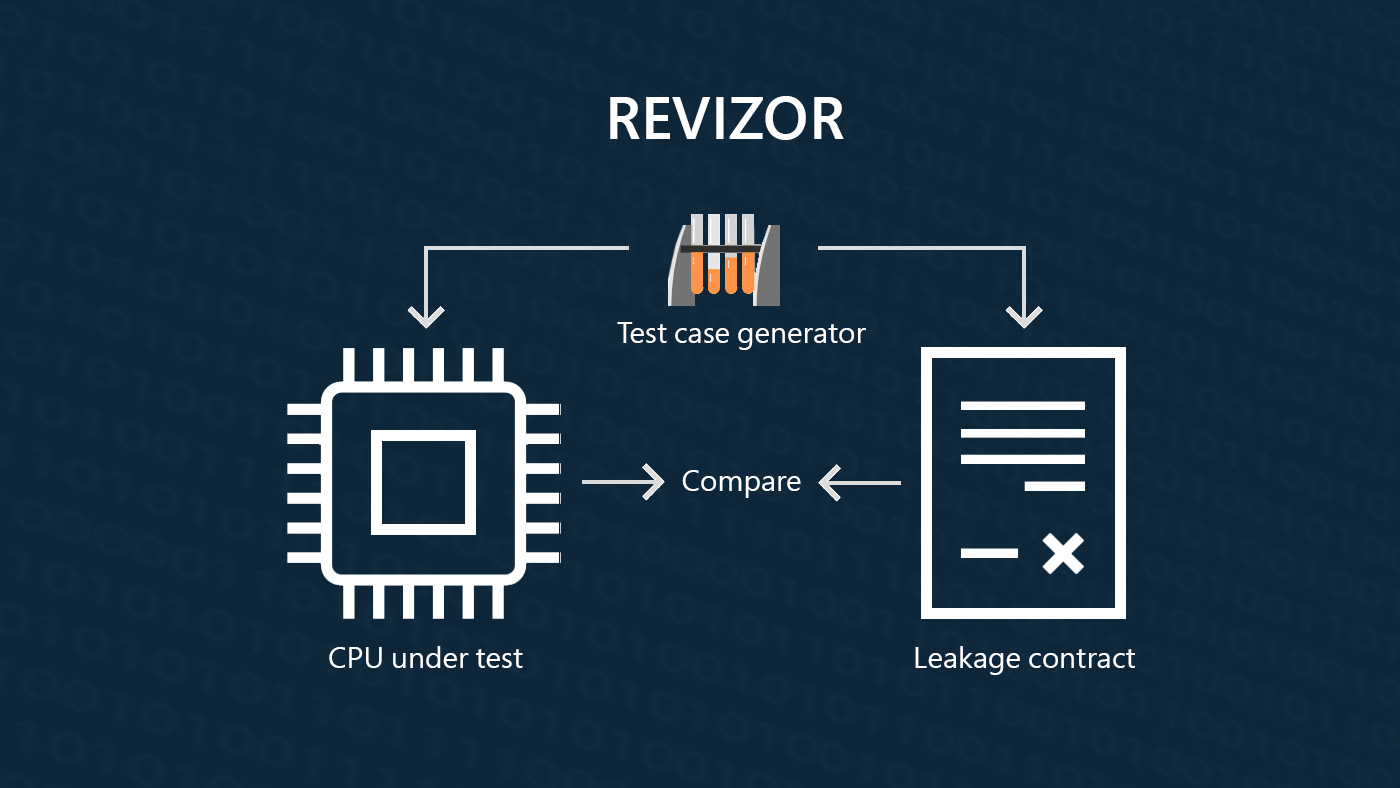By Rob Knies, Managing Editor, Microsoft Research
Rane Johnson-Stempson (opens in new tab) recalls vividly the moment last spring when she first encountered Katie Doran.
“I had the opportunity to meet Katie in Seattle during the Graduate Cohort Program of the Computing Research Association’s Committee on the Status of Women in Computing Research (opens in new tab) [CRA-W],” recounts Johnson-Stempson, principal research director of Education and Scholarly Communication for Microsoft Research Connections (opens in new tab). “She was presenting a poster on her research on educational technology and serious games.
MICROSOFT RESEARCH PODCAST
AI Frontiers: The future of scale with Ahmed Awadallah and Ashley Llorens
This episode features Senior Principal Research Manager Ahmed H. Awadallah, whose work improving the efficiency of large-scale AI models and efforts to help move advancements in the space from research to practice have put him at the forefront of this new era of AI.
“She was discussing her research on how emerging game technologies, specifically ubiquitous and augmented-reality gaming, can be used to facilitate new interaction that promotes learning and skill adoption for players more effectively. I realized that she was the young lady I would like to do research with and have her help us with our education research and gender research.”
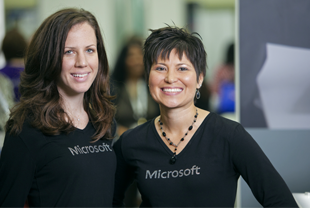
Katie Doran (left) joins Rane Johnson-Stempson during the 2012 Grace Hopper Celebration of Women in Computing.
Doran, a Ph.D. student at North Carolina State University, was invited to intern alongside Johnson-Stempson, and, from all appearances, it has been the start of a longtime collaboration.
“Working with Rane has been fantastic,” Doran says. “She is truly passionate about the work she does to encourage more women to join computer science. Rane has been the perfect mentor: She’s supportive, welcoming of new perspectives, and eager to see me succeed. She’s so much more than my boss during my internship. She’ll be a lifelong friend and mentor.”
Passion, support for women in computer science, mentorship—these are precisely the attributes shared by the more than 3,000 attendees of the 12th annual Grace Hopper Celebration of Women in Computing (opens in new tab), being held Oct. 3-6 at the Baltimore Convention Center. The event, named after computing pioneer Grace Hopper, is the largest technical conference that showcases the work of technical women around the world.
Naturally, Microsoft’s support for such a conference is robust. Johnson-Stempson, who is leading the company’s efforts to support women in technology and to inspire young women to pursue careers in science, technology, engineering, and math, worked with members of the sponsoring organization, the Anita Borg Institute for Women and Technology (opens in new tab), to bring 165 women leaders from Microsoft to the event. Fourteen of the Grace Hopper Celebration speakers are representing Microsoft, and the company is participating in a number of high-profile events aligning with the conference.
It’s all a measure of Microsoft’s commitment to recruiting and retaining the best and brightest women in technology and helping to mentor the future generation of women leaders in computer science. For example, Microsoft Research has announced its support of the NetHope Academy’s Women’s TechConnect (opens in new tab) program and of a celebration for winners of the National Center for Women & Information Technology (opens in new tab) (NCWIT) Award for Aspirations in Computing (opens in new tab).
The latter event, held Oct. 4 and sponsored by Microsoft Research, celebrated the achievements of 50 past and current winners of the Aspirations in Computing award from around the country. Peter Lee (opens in new tab), corporate vice president of Microsoft Research Redmond (opens in new tab), was on hand to speak and celebrate the winners, along with Johnson-Stempson, Doran, and Lindsay Lindstrom, a technical evangelist for Microsoft’s Developer and Platform Evangelism (DPE) group.
Microsoft Research sponsored an NCWIT Academic Alliance reception and spoke on the importance of the work done by the alliance to recruit and retain more women in computer science across the nation.
Ruthe A. Farmer (opens in new tab), NCWIT director of Strategic Initiatives, appreciates the Microsoft support.
“As the national affiliate sponsor, Microsoft support has made it possible for us to bring the NCWIT Award for Aspiration in Computing to aspiring technical young women across the entire United States,” Farmer says. “In 2012-’13, we expect to recognize a thousand girls through 55 events nationwide.
“Having Microsoft as a partner adds clout to the program and helps garner community support. Other stakeholders see this and think, ‘If one of the biggest software companies in the world cares about this, maybe we should, too.’”
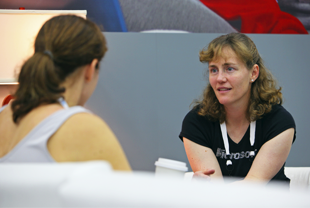
A.J. Bernheim Brush (right) of Microsoft Research Redmond chats with an acquaintance during the Grace Hopper Celebration of Women in Computing.
In fact, it’s difficult to scan the Hopper Celebration agenda and not be struck by the depth of the Microsoft involvement. On Oct. 4, an executive panel discussion was moderated by Jennifer Chayes (opens in new tab), managing director of Microsoft Research New England (opens in new tab) and Microsoft Research New York City (opens in new tab), with Lee sitting on the panel. Henrique Malvar (opens in new tab), Microsoft Research chief scientist, also is an active participant during the conference.
Microsoft speakers during the event include:
- Johnson-Stempson, discussing Mentoring Your World: Introducing Women’s TechConnect.
- Meredith Ringel Morris (opens in new tab), researcher at Microsoft Research Redmond, speaking on Publishing Your Research.
- A.J. Bernheim Brush (opens in new tab), senior researcher at Microsoft Research Redmond, addressing The Graduate School Experience.
- Linda Apsley, from Xbox LIVE (opens in new tab), talking about What If Women Were Extremely Effective Leadership Communicators?
- Lili Cheng (opens in new tab), general manager of Microsoft Research’s FUSE Labs (opens in new tab), discussing Creativity, Learning, and Social Software.
- Jennifer Marsman, of DPE, explaining How to Get There: Secrets for Success, in the Style of GLEE.
- Maria Alvarez, from the Advertising Research and Development group, talking about Recruiting and Retaining Women from Under-Represented Groups.
- Yunling Wang, of SharePoint Data Center, moderating a panel discussion called Go Lean, Go Agile – Are We There Yet? The panel included Rae Wang of Microsoft’s Exchange Online team.
- Yina Arenas, from the SharePoint (opens in new tab) team, moderating one panel discussion and facilitating another. The first, called Are We There Yet? Finding Your Career Sweet Spot, included Rosa Enciso of MSN (opens in new tab). The second, Juggling Our Different Worlds, included Enciso and Natalie Gil of Microsoft LATAM.
- Michelle Chua, of Microsoft Studios, participating in a discussion called Epic Win: Opening Doors for Women in Games Research and Development.
- Kate Tsoukalas, with the Windows Phone group, serving as a facilitator for a segment entitled Are We Ready for the Next Level Yet? Perspectives from Junior Women in Technology.
Other key Microsoft participants in the Hopper Celebration include Laura Kern, Katharine Holdsworth, Michelle Holtmann, Sara Spalding, and Vasiliki Gkiza.
Microsoft also sponsored a couple of Anita Borg Institute awards (opens in new tab):
- The 2012 Anita Borg Social Impact Award goes to Cathi Rodgveller, founder of IGNITE—Inspiring Girls Now in Technology Evolution. In the 13 years Rodgveller has administered the IGNITE program, thousands of middle school and high school girls have learned that their array of career options are much deeper than they might have imagined—girls who, studies have shown, are precisely the age when many lose interest in STEM studies.
- The 2012 Denice Denton Emerging Leader Award goes to Susan Daniel, assistant professor of chemical and biomolecular engineering at Cornell University. Her research group studies phenomena that occur at interfaces and biological surfaces, focusing on two themes: the dynamic organization of biomolecules in cell membranes and its impact on biological function, and the interaction of viruses with cell membranes and the entry processes that lead to infection.
Chayes and Rick Rashid (opens in new tab), Microsoft chief research officer and head of worldwide operations for Microsoft Research, presented both awards.
“By increasing the diversity of our workforce, we enhance our ability to tap into segments and markets in a competitive way,” says Rashid, also a member of the Anita Borg Institute board of trustees.
Lee and Johnson-Stempson also participated in the awards ceremony. The latter underscores the importance of such recognition.
“As a company,” she says, “we want to build the greatest in technology innovation. This requires that our researchers and engineers are on the most diverse teams, with individuals who think differently, approach problems differently, and come to solutions in different ways.”
Also on Oct. 4, Telle Whitney, president and CEO of the Anita Borg Institute, announced the official launch of the Women’s TechConnect program, which supports women in the field with on-the-job skills development, mentoring, and collaborative problem solving to help propel women from entry-level positions to leadership roles. The program gives women in underdeveloped countries and disaster-prone areas the technical skills to assist in case of emergency.
Women from Microsoft Research and Microsoft employee groups are sponsoring three women from Haiti and one from Kenya in the Women’s TechConnect program, and efforts are under way by women from Microsoft to raise money to support TechConnect so more women can join the program.
“It’s no secret there’s a dearth of women in IT,” Johnson-Stempson says. “The situation is even worse in emerging economies, especially international development. It is this type of support in education and mentorship that will help grow more women in the developing worlds into computer science and technical fields.”
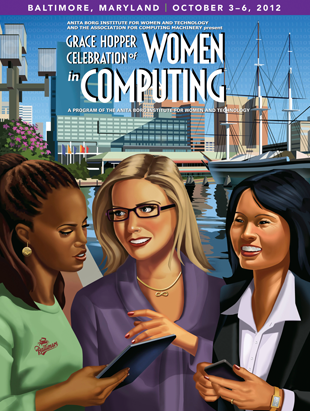
Cover of the program for the 2012 Grace Hopper Celebration of Women in Computing.
Her intern, Doran, has spent much of her internship at Microsoft Research evaluating ChronoZoom (opens in new tab), a novel visualization of “big history,” as an educational tool. But she, too, has found time to advocate for getting more women involved with computer science.
“I’ve had the opportunity to involve myself in a good deal of gender and diversity outreach,” Doran says, “including coordinating visits to the Microsoft campus for two groups of students and promoting Microsoft Research’s incredible outreach tools during STARS Celebration 2012 (opens in new tab).”
This interest, too, caught Johnson-Stempson’s attention during the CRA-W event earlier this year.
“She spoke to my heart when she discussed her work in northern Haiti as part of the One Laptop per Child deployment,” Doran’s mentor says. “Not only did she teach students and teachers basic computer knowledge, but also game development. In addition, she was in charge of setting up a school server at one of the Haitian schools that allowed the One Laptop per Child laptops to network together, and she hosted an online-learning-management system, where teachers could host learning materials for the students to access.”
Such passion is something that ties mentor and mentee together—and works to provide ongoing support to entice girls and young women to consider a career in computer science.
“Computer science can empower people to find their own solutions to problems,” Doran says. “It encourages innovation and enables people to create, rather than simply consume, technology. The potential for people to achieve great things through computer science is incredibly high, and I think the more people who have the skills to reach that potential, the better.
“Unfortunately, there are clearly under-represented groups—women, minorities, and people from lower socioeconomic backgrounds. These groups should have the same opportunities for greatness that our well-represented groups have had, and I want to make that happen.”

